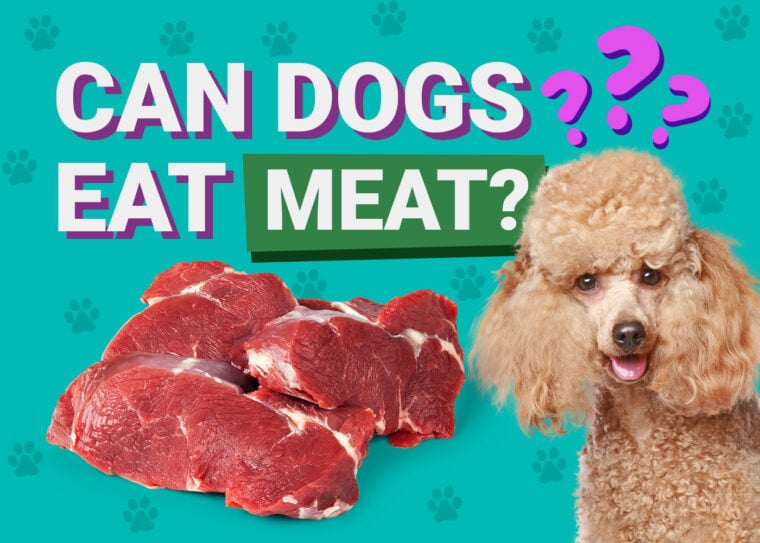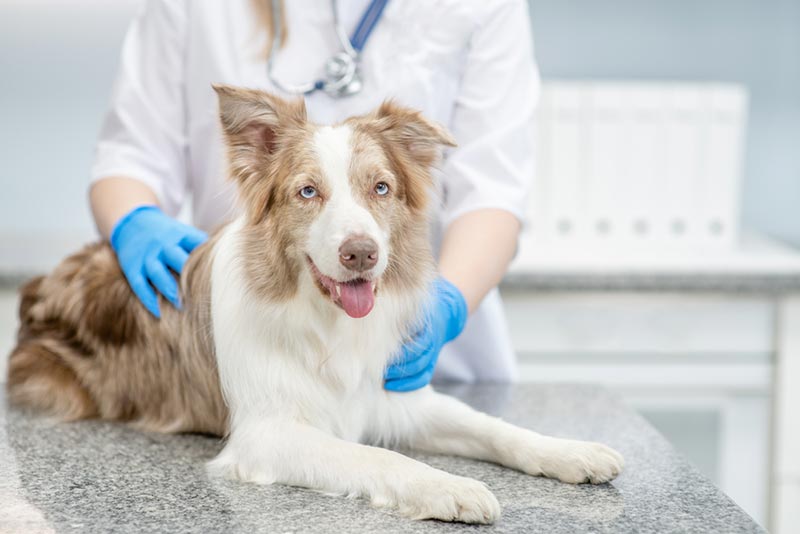
How we feed our dogs has changed drastically over the years. Our knowledge of dog nutrition has advanced as science has progressed and experts have learned what kinds of food benefit dogs the most. A recent trend is feeding dogs a raw diet, which of course, includes raw meat.
But is raw meat safe for dogs? There is no simple yes or no answer to this question. Whether a dog can eat raw meat depends on the quality and type of meat and the dog themselves.
Here, we discuss the advantages and risks of giving raw meat to dogs in the hopes that this information will help you make the right choice for your dog.
Why a Raw Food Diet?
There are several reasons that some dog owners advocate for a raw diet.
Wild Ancestors
The premise behind the raw food diet is that it emulates the diet of the wild ancestors of our domestic dogs: the wolf. It’s believed that the domestication of dogs might have started in Siberia about 23,000 years ago.1
Wolves’ main diet is raw meat, and it’s believed that dogs have the same biological and physiological systems as wolves and so will thrive on a raw diet and that it is more natural to feed raw meat to dogs.

Distrust of Commercial Diets
Another reason many dog owners have opted for a raw diet for their dogs is that they have concerns about commercially prepared food with multiple recalls.
Raw food advocates believe that a dog’s digestive system is designed to efficiently digest raw meat and that it contains digestive enzymes that effectively destroy dangerous bacteria.
It’s also thought that the cooking and processing of commercial dog food destroys these enzymes, reducing the food’s quality.
Health Benefits
Raw diet advocates state that the diet has several health benefits for dogs. For one thing, dogs can digest raw food faster than kibble, resulting in smaller and less smelly stools.
Since the food is easier to digest, it can also promote healthier skin and coats. Most dog food manufacturers have to add the appropriate vitamins and minerals to achieve the kinds of results that are naturally occurring in raw food.
Finally, there have been statements that raw diets can improve dogs’ dental health. Chewing on bones helps with tartar buildup, and the bones are a natural source of phosphorus and calcium.

The Risks of Raw Meat
While there seem to be a few advantages to feeding raw meat to a dog, many veterinarians and the U.S. Food & Drug Administration (FDA), the American Veterinary Medical Association, and the Centers for Disease Control & Prevention discourage feeding raw food to dogs.
Dangerous Bacteria
This is the most obvious and dangerous reason that raw food is risky. The danger not only affects your dog but also you and your family.
Raw meat can contain Salmonella and E. coli, which are usually eliminated through cooking. If your dog is eating raw meat, there’s also the risk of people in the household contracting a bacterial infection or foodborne illness.
Handling the meat, cleaning up your dog’s feces, and touching any surfaces that are contaminated can increase the chance of infection, as well as your dog licking your face.
This is a particularly significant concern if you have young children or someone who is immunocompromised living in the home. Dogs don’t always show signs of bacterial infection, so you might think that everything is fine when it isn’t.

Unbalanced Nutrition
If you decide to acquire the raw food yourself, you might find that it takes a great deal of time and money. Also, homemade diets don’t undergo the same testing as commercially prepared foods.
If you want to try homemade raw foods rather than ones commercially prepared raw, you will need to follow a veterinary nutritionist’s meal plan to ensure that your dog has a nutritionally balanced diet.
While you have better control of their food intake when you prepare raw meals for your dog, you must ensure that you have the right ingredients in the exact amounts.
Different Nutritional Needs
The wild relatives of today’s dogs are quite distant at this point. Dogs have evolved significantly since they were domesticated, so a primarily raw meat diet won’t actually be nutritionally balanced for them.
Wolves eat the entire animal, which means they eat muscle, bone, skin, fur, tendons, and organs, giving wolves a nutritionally complete diet. Many dog owners will only feed their dogs raw meat, which tends to be primarily muscle meat. This means they are missing fiber, fat, and certain essential vitamins and minerals.

Bones
Including bones in your dog’s raw diet can be both beneficial and risky. Raw food advocates state that chewing on bones helps a dog’s oral health and can add phosphorus and calcium to their diet.
But bones are also capable of splintering and causing damage to the dog’s mouth and puncturing the stomach lining and intestines. They can also cause a blockage in the windpipe, esophagus, and stomach and lead to broken teeth. The FDA advises that dogs shouldn’t be given bones.
Speak to Your Veterinarian
If you still want to give your dog a homemade raw food diet, you should first speak to your vet. They can inform you how to keep it nutritionally balanced and how to best prepare the food to keep your dog and your family safe.
If your dog can’t eat raw food because of a health condition, your vet can work with you to figure out what kind of food will keep your dog healthy and happy.

Preparing Raw Food
You should follow the FDA’s tips on preparing raw food for your dog:
Conclusion
Raw dog food is a topic that is quite divisive. Some people advocate that it’s the best way to keep your dog healthy, while others believe that it isn’t necessary and not worth the health risks.
If you decide that you want to give homemade raw food a try, we highly recommend that you speak to your vet and have a veterinary nutritionist get involved. This way, you can ensure that your dog will receive the right balance of nutrition.
If you don’t want to deal with raw meat, there are plenty of fresh fruits and vegetables that can be healthy and safe additions to your dog’s meals.
See Also:
- Can Dogs Eat Pastrami? Vet Reviewed Dietary Guidance
- Can Dogs Eat Gyro Meat? Vet Approved Facts & Safety Guide









